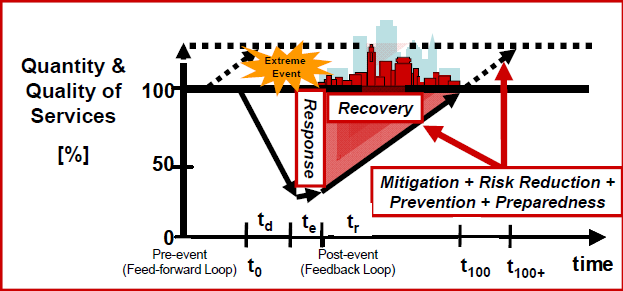The P.E.O.P.L.E.S. Framework

The PEOPLES Framework represents an interesting instrument by which we can organize the various data availaible for determining resilience at different scales.
PEOPLES Resilience Framework is based on basic community organizational units at a local (i.e., neighborhoods, villages, towns or cities) and regional scale (i.e., counties/parishes, regions, or states).
The following describes briefly each of the seven component-dimensions associated with the PEOPLES Resilience Framework.
1) Population and Demographics
Population and demographic data that describe and differentiate a focal community provide a context for understanding the remaining PEOPLES dimensions. Knowing, for example, the median income and age distribution for a community is critical to understanding its economic health and potential resilience. Communities tend to differ on key demographics; to the extent that two or more communities may be similar, Community A and Community B, we can predict Community B’s hypothetical response to a disaster based on Community A’s actual response to a disaster.
One measure of functionality of population and demographics (Qp) within a given community can be quantified by using the social vulnerability index (SoVI) proposed by Cutter (1996).
Key indicators include educational attainment, marital status, annual income, age, gender, race/ethnicity distribution, and other data that describe and differentiate the focal population.
2) Environmental and Ecosystem
Ecological or ecosystem resilience is typically measured by the amount of disturbance an ecosystem can absorb without drastically altering its functions, processes, and structures (Gunderson, 2000), or by the ability of an ecosystem to cope with disturbance.
One such indicator is the Normalized Difference Vegetation Index (NDVI), which is calculated from satellite-derived remote sensing imagery that analyzes the density of green vegetation across a region.
3) Organized Governmental Services
In contrast to the more or less spontaneous individual and neighborhood responses to extreme events, organized governmental services are designed to allow an orderly response.
Organized governmental services plays a key role in sustaining communities both before and after extreme events. In addition to assessing the availability of government services in terms of personnel and equipment, this dimension also includes an evaluation of emergency preparedness planning. For example, surveys may reveal the extent to which organized government services have developed memoranda of understanding (MOUs) and other types of mutual aid agreements, and the extent to which various organized government services participate in emergency and evacuation drills and table-top exercises.
4) Physical Infrastructure
The physical infrastructure dimension focuses on a community’s built environment. It incorporates both facilities and lifelines. Within the category of facilities, we include housing, commercial facilities, and cultural facilities. Within the category of lifelines, we include food supply, health care, utilities, transportation, and
communication networks.
Next to impacts on people, the physical infrastructure is often the most compelling “story” in the
immediate aftermath of a disaster, as organized government services work to restore needed
utilities and clear roadways of structural and other debris.
In the aftermath of a disaster, the restoration and recovery of physical infrastructure remain byand-
large technical issues, however those are tightly related and often driven by organizations,
economics and socio-political events. The resilience must consider these interactive dimensions
in order to be relevant to the system.
5) Lifestyle and Community Competence
Community competence is essential to community resilience in the same way that individual competence is essential to personal hardiness. Community competence deals with community action, critical reflection and problem solving skills, flexibility and creativity, collective efficacy, empowerment, and political partnerships.
Quality of life surveys often reveal whether members of a given community are committed to that community and willing to engage in the activities necessary to sustain the community, regardless of whether a disaster strikes. Less soft general indicators of community competence may include measures of migration, measures of citizen involvement in politics, and others. Disaster-specific indicators may include the comprehensiveness of community warning plans and procedures, and the extensiveness of citizen and organizational disaster training programs.
6) Economic Development
Economic development includes both the static assessment of a community’s current economy (economic activity) and the dynamic assessment of a community’s ability to continuously sustain economic growth (economic development). As described in the RICSA Poverty Project (2010), economic activity takes into account the supply of labor for the production of economic goods and services.
Diversity in production and employment is linked to a community’s ability to substitute goods and services and shift employment patterns as the situation demands. Primary indicators of this dimension include the proportion of the population that is employed within the various industries, and the variability that might characterize a community’s industrial employment distribution.
7) Social-Cultural Capital
Social/cultural capital is prerequisite to community competence (Norris et al., 2008) in that it incorporates the array of services that the community has chosen to provide for itself, understanding that community health requires more than good jobs and infrastructure. It also includes several intangible “goods,” such as social support, sense of community, place attachment, and citizen participation.
It seems likely that people with a strong “place attachment” would be more willing to act in order to help their community bounce back after a disaster, assuming that other essential factors such as employment and housing were available.
Measuring social/cultural capital requires acquisition of tallies, such as the number of members belonging to various civil and community organizations. It also requires surveys of community leaders and their perceptions (e.g., quality of life surveys). Disaster-specific indicators include existence of community plans targeting transportation-disadvantaged populations, adequacy of post-disaster sheltering plans, adequacy of plans for incorporating volunteers and others into official response activities, adequacy of donations management plans, and the community’s plans to coordinate across diverse community networks.

